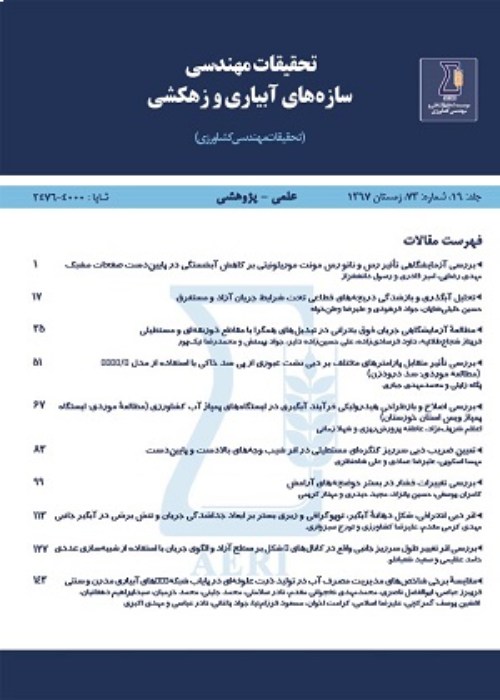Zoning analysis of physical water productivity index in the hubs of sugar beet production in Iran
Iran is characterized by a dry and semi-arid climate. The limited irrigated arable land in and the need for increasing food production due to the upward trend in population growth, coupled with water scarcity and Iran's heavy reliance on irrigation, have led to a heightened importance of water productivity in agricultural sector. In this regard, for the purpose of identifying and understanding the agricultural potential of farmlands, the analysis and estimation of physical water productivity can be utilized. The main objective of conducting this research is to evaluate various interpolation methods and to select the most appropriate method for estimating the physical water productivity of the sugar beet. Additionally, the study aims to investigate the spatial distribution pattern of sugar beet production in its major cultivation centers across Iran.
To accomplish this research, 108 field measured data obtained from selected sugar beet farms across Iran for the agricultural year 2016-2017 were used. Data on crop yield, irrigation water, and a ten-year average effective precipitation were collected, and the water productivity index of sugar beet was calculated for the selected farms.To achieve this goal, initially, the data was analyzed using the capabilities of the SPSS software. Descriptive statistical analysis was conducted, and similar regions were classified into independent and homogeneous groups (by drawing a dendrogram). Additionally, the spatial analysis of the data was carried out using the GS+ software. Furthermore, various interpolation methods were employed to create a classification map using the Geographic Information System (GIS) software. These methods encompass algebraic methods, including weighted inverse distance, radial basis function, global polynomial, and local polynomial methods, as well as geostatistical methods like ordinary kriging, simple kriging, and universal kriging. To assess the different interpolation methods, validation methods were employed, and accuracy index values such as Mean Bias Error (MBE), Mean Absolute Relative Error (MARE), Mean Squared Error (MSE), Mean Absolute Deviation (MAD), and Root Mean Square Error (RMSE) were utilized.
The results of the present study revealed that the water productivity index for sugar beet ranged from 2.60 to 13.11 kg/m³, with an average of 6.30 kg/m³. Despite the high standard deviation, the findings indicate a significant potential and high capacity for improving water productivity and crop performance in the sugar beet production hubs in Iran. Among the examined interpolation methods, the Radial Basis Function method with a completely regular spline model (CRS) exhibited acceptable accuracy (MBE=0.009) for generating the water productivity zoning map. The analysis of the generated map suggested that the western regions of the country, especially Kermanshah province, have higher water productivity index values compared to other parts of the country, making them more suitable for sugar beet cultivation. Furthermore, cluster analysis results for influential factors such as variety type, soil salinity, and irrigation water salinity indicated that within the study area, about 5% of the potential sugar beet cultivation areas could be divided into 23 distinct clusters. The minimum and maximum water productivity index were observed in cluster 11 (2.64 kg/m³) and cluster 3 (11.025 kg/m³), respectively.
Based on the low level of correlation coefficient according to the results of the Pearson correlation test, the physical productivity of water utilization can be influenced by various factors other than precipitation and climate parameters. These factors include salinity of water, soil salinity, total irrigation water, average effective precipitation (over a ten-year period), and crop yield. It can be concluded that, in addition to precipitation and climatic parameters, other constant factors including management factors have an impact on improving the physical efficiency of water utilization.
Given the high water consumption in agricultural sector and the need for increased production in cultivated lands, evaluating the water produvtivity of high-water-demand crops such as sugar beet in Iran is essential. Understanding its current state and obtaining comprehensive information from fields, as well as monitoring cultivated fields, are necessary for decision-making and macro-level planning to enhance and improve water productivity of sugar beet cultivation in Iran. However, due to the extensive cultivation area, costs, limited resources, and time constraints, this task is challenging and often unfeasible. To address this, the potential of interpolation tools can be utilized. These tools have the capability to extrapolate point-based information to spatial information (area-wide). Results have shown that the highest and lowest error values were associated with the kriging interpolation method and the radial basis function (completely regularized spline) method, respectively, for creating zoning maps. In conclusion, it can be stated that through interpolation, if there is a strong correlation between the data, a better understanding of the spatial distribution of water productivity can be achieved in the study area.
- حق عضویت دریافتی صرف حمایت از نشریات عضو و نگهداری، تکمیل و توسعه مگیران میشود.
- پرداخت حق اشتراک و دانلود مقالات اجازه بازنشر آن در سایر رسانههای چاپی و دیجیتال را به کاربر نمیدهد.


